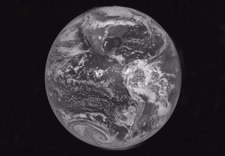NOAA's GOES-15 Weather Satellite Captures Its First Image of Earth
GOES-15, launched on March 4 from Cape Canaveral, Florida, joins three other NOAA operational GOES spacecraft that help the agency's forecasters track life-threatening weather—from tornadoes, floods and hurricanes—and solar activity that can impact the satellite-based electronics and communications industry. The black and white full-disk image shows North and South America with a storm system visible across the United States, indicated by a drape of clouds from New England westward to the central Plains. Further west is a cold front over the Rocky Mountains. Mostly clear skies are seen over the mid-Atlantic, southeastern U.S., Gulf of Mexico, California and Mexico. (More)






